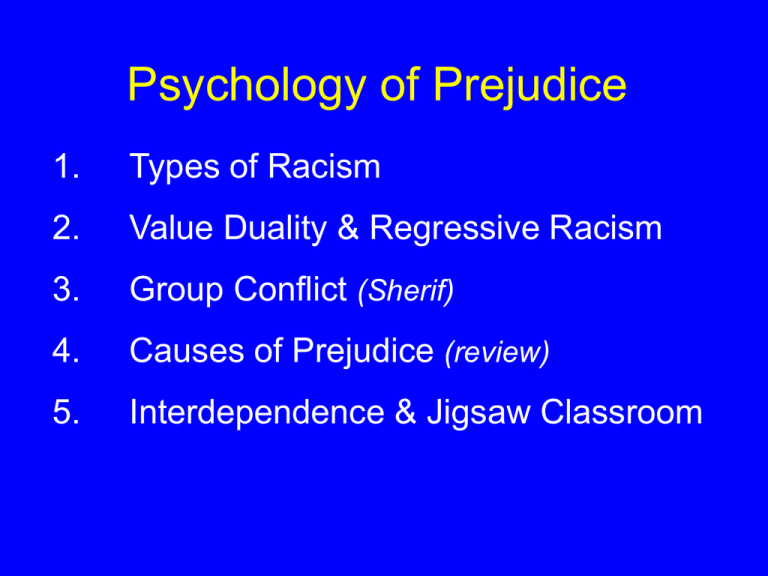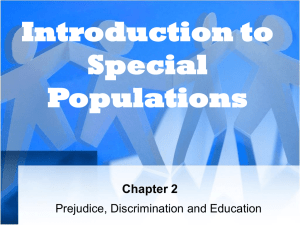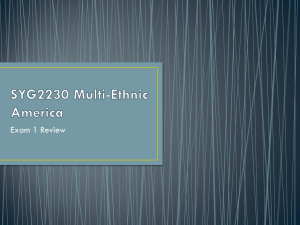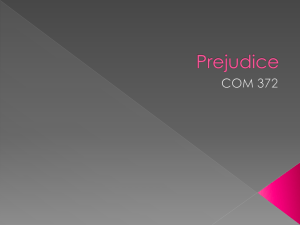Psychology of Prejudice
advertisement

Psychology of Prejudice 1. Types of Racism 2. Value Duality & Regressive Racism 3. Group Conflict (Sherif) 4. Causes of Prejudice (review) 5. Interdependence & Jigsaw Classroom Definitions J. Kovel, White Racism • Racism: social institutions which disadvantage a group • Prejudice: a person’s negative stereotypes, hostility, misunderstandings Types of Prejudice Joel Kovel: White Racism • Dominative Racism • Aversive Racism • Metaracism Dominative Racism • Southern Slavery • Face-to-face domination • Emotionally “hot” – Aggression – Sexuality Aversive Racism • Northern segregation • Separation; distance • Emotionally “cold” – Pollution – Dirt Metaracism • Post-Civil Rights Movement • Official anti-discrimination • Institutional Racism – Discrimination & inequality preserved without personal prejudice – Stereotypes operate automatically – Value duality & ambivalence – “reverse” & “regressive” racism Ambivalence / Value Duality Theories • Katz & Hass: Attitudinal Ambivalence Value Duality • Rogers & Prentice-Dunn: Reverse Racism & Regressive Racism Ambivalence / Value Duality ( Katz & Hass ) • Background Stigma ambivalence quick to help, exonerate quick to blame, avoid, reject White Attitudes • Less overt prejudice; still covert prejudice • Lip-Service? • Positive & negative “side by side”? • Co-existence of anti-discrimination attitudes & racial bias • Duality: Blacks seen as disadvantaged & deviant Unintentional Harm Experiments • Subjects who inflict unintentional harm derogate (view negatively) their victims • Cognitive dissonance theory: harm dissonance justification Unintentional Harm Experiments • Whites shock confederates (black or white) Give more negative “personal impressions” of blacks than whites • Prejudice scale & sympathy scale ( Uncorrelated ) • Whites high on both -- “ambivalent” -- gave most derogatory views of black “victim” Post-Harm Helping Experiment • White subjects shock black vs. white • “Victim” departs, leaving request for help on research project: writing sentence many times • Subjects give black “victims” 3 times the help they give to white “victims” Value Duality • Egalitarianism Blacks as disadvantaged (Egalitarianism scale) • Competitive Individualism Blacks as deviant (Protestant Ethic scale) Attitude Ambivalence Study • Pro-black scale (r = .58 with scale of egalitarian values) • Anti-black scale (r = .49 with scale of Protestant Ethic values) • Ambivalence = pro score X anti score Attitude Ambivalence Study • 100 Subjects (college students) • Student endangered by chem lab fire • Questionnaire with 4 versions: – White X Black main character – Brave X Timid actions • Higher ambivalence higher praise & blame of blacks Conclusion “A substantial number of whites hold two opposing and contradictory racial attitudes, one friendly and the other hostile. “This ambivalence can cause behavior toward minority persons to be unstable and extreme – in either a positive or a negative direction, depending on the situation. Regressive Racism ( Rogers & Prentice-Dunn ) • New egalitarian norms “reverse discrimination” (preferential treatment) “Behavior Modification” / “Biofeedback” Experiment • 96 white college S-s in groups of 4 • Monitoring confederate’s heart rate • Giving shocks when heart rate drops • Dependent Variable: shock intensity shock duration 2 x 2 x 2 Factorial Design Insult Yes No Yes No Yes No Yes No Deindividuation Victim Yes White No Yes Black No Results • Main effect of deindividuation – Deindividuation higher shock • No main effect of race of victim • Interaction effect of insult & race Race X Insult Interaction Effect Regressive racism Reverse discrimination Discussion • Ambivalence: Katz’s ambivalence amplification • Disinhibition: de-indiv & insult allow deep-seated prejudice to be expressed • Regression: de-indiv & insult cause regression to older prejudice Conclusions Americans take a Janus-faced view of interracial encounters, one face looking forward but the other face focusing grimly on the past. Implications • In conditions of meta-racism… many whites feel anxious & ambivalent. • They hold sincere anti-prejudicial attitudes… but when threatened, quick to reject and “slip into” stereotyping What to do? …to overcome ambivalence & prejudices Boys’ Camp Experiment on Group Conflict Muzafir Sherif 1956 “Robbers’ Cave” Camp • Mapped friendship networks • Introduced group competition • Mapped new friendship networks • Observed behavior • Non-competitive social interaction • Staged Emergency No groups: friendship networks formed In-Group Formation: New Friendship Networks In-Group Formation: New friendship networks Robbers Cave Experiment Group Competition Group Competitions • In-group solidarity + prejudice against out-group • Hostility: scuffles & raids • Bullies become leaders & heroes • Epithets (even for former “best friends”) “Ladies first!” “Get the dirt off!” How to Reduce Conflict? Friendly social interaction: more hostility, epithets, taunting Staged Emergency Staged Emergency • Rattlers & eagles cooperate • Hostility, taunting drop • New cross-group friendships form “Robbers’ Cave” Camp • Opportunities for pleasant interaction continued hostility • Interdependence (staged emergency) decreased hostility, cooperation, re-formed friendship patterns Causes of Prejudice ( Elliot Aronson ) • Low social status • Scapegoating • Authoritarian Personality • Realistic Group Conflict • Conformity to Social Norms Causes of Prejudice ( Elliot Aronson ) • Low socio-economic status higher prejudice Causes of Prejudice ( Elliot Aronson ) 1. Economic & political competition ( “realistic group conflict theory” ) Sherif experiment Causes of Prejudice ( Elliot Aronson ) 2. Scapegoat Theory frustration displaced aggression – Jews as scapegoats in Nazi Germany – Lynchings correlated with cotton prices – Pogroms against Chinese in Indonesia Causes of Prejudice ( Elliot Aronson ) 3. Prejudiced Personality Authoritarian Personality Causes of Prejudice ( Elliot Aronson ) 4. Conformity to community norms people who move shift attitudes miners: prejudiced above ground integrated below “Stateways can change folkways” • Changing attitudes often doesn’t change behavior • Changing behavior often changes attitudes De-segregation • “Equal status contact” succeeds • “Inequality & competition” increases hostility Successful Integration • Equal Status + Interdependence – Sherif experiment • Jigsaw Classroom http://www.jigsaw.org/ What to do? Inter-dependence ! ! !



